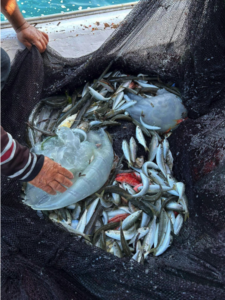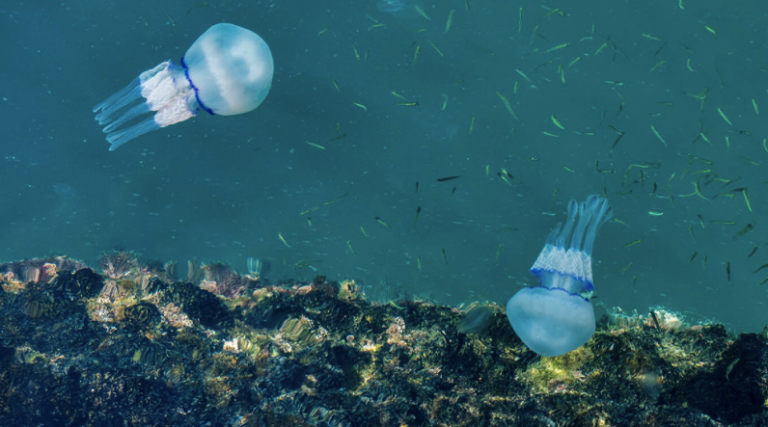A relatively rare species of jellyfish for the Greek seas was found in Rhodes in the last 24 hours revealing the effects of the climate crisis in our region.
It is the species Rhopilema nomadica which can reach up to one meter in diameter, hemispherical shape and transparent – bluish color.

The jellyfish sighting published by the Rhodes Hydrobiological Station
Specifically, according to a post of the Hydrobiological Station of Rhodes, this species is endemic to the Red Sea, and in the Mediterranean the first record of the species was made in 1970, since 1980 periodically appears in the Greek seas, and instructions are given and precautionary instructions for citizens as it is recommended to avoid contact, since they have poison.
In recent years a massive invasion of jellyfish has been observed in the Greek seas.
These are tropical or subtropical species, most of which began to invade Mediterranean waters after the construction of the Suez Canal in 1869.
In fact, the alien – to the Mediterranean ecosystem – species were called Lessepsian migrants, taking their name from the French canal engineer Ferdinand Lesseps.
However, data show that the Mediterranean Sea has the highest number of biological invasions in the world.
UPDATE TO THE COMMUNITY
Staff of the Rhodes Hydrobiological Station spotted 4 individuals of Rhopilema nomadica yesterday (11/3) and today (12/3) in the Gulf of Triantes.
This species is endemic to the Red Sea, and in the Mediterranean the first record of the species was made in 1970.
Rhopilema nomadica, also known as the nomadic jellyfish, is hemispherical in shape, transparent – bluish in colour, and its diameter can reach 1 metre.
On the lower surface of the body, there are 8 tentacles with filaments, i.e. small stingers with venom, which, if they come into contact with the skin, cause intense pain, burning sensation, itching and irritation of the area.
Even if you find a jellyfish on the beach, avoid contact with bare hands!
In case of skin contact, follow these steps:
1. 1. Do not touch the jellyfish with your bare hands.
2. Rinse with salt water or vinegar, but do not scrub the area. Do not use fresh water!
3. Do not cover the area with bandages.
4. As symptoms may vary from person to person, do not use pharmaceutical preparations without medical advice.
5. If pain and swelling persist, consult a doctor.
6. In the case of an allergic person, that person should contact/go to a doctor or hospital immediately.
Since the 1980s, periodic population outbreaks have been recorded in the Greek seas.
PM Mitsotakis gave a comprehensive interview covering all current affairs
The occurrence of jellyfish outbreaks is a transient phenomenon that usually lasts from a few hours to a few days, and depends mainly on the sea currents.
At the same time, the increase in global and therefore sea temperature due to climate change creates favourable conditions for the occurrence of such outbreaks in jellyfish populations.
Characteristically, in previous years, the sea temperature on the coast of Rhodes in the period February-March was usually 16o C, while this year for the same period, the temperature is almost 19o C!
In addition, the decline of sea turtles, for which jellyfish are a staple food, contributes to the increase in the jellyfish population.”
Ask me anything
Explore related questions





